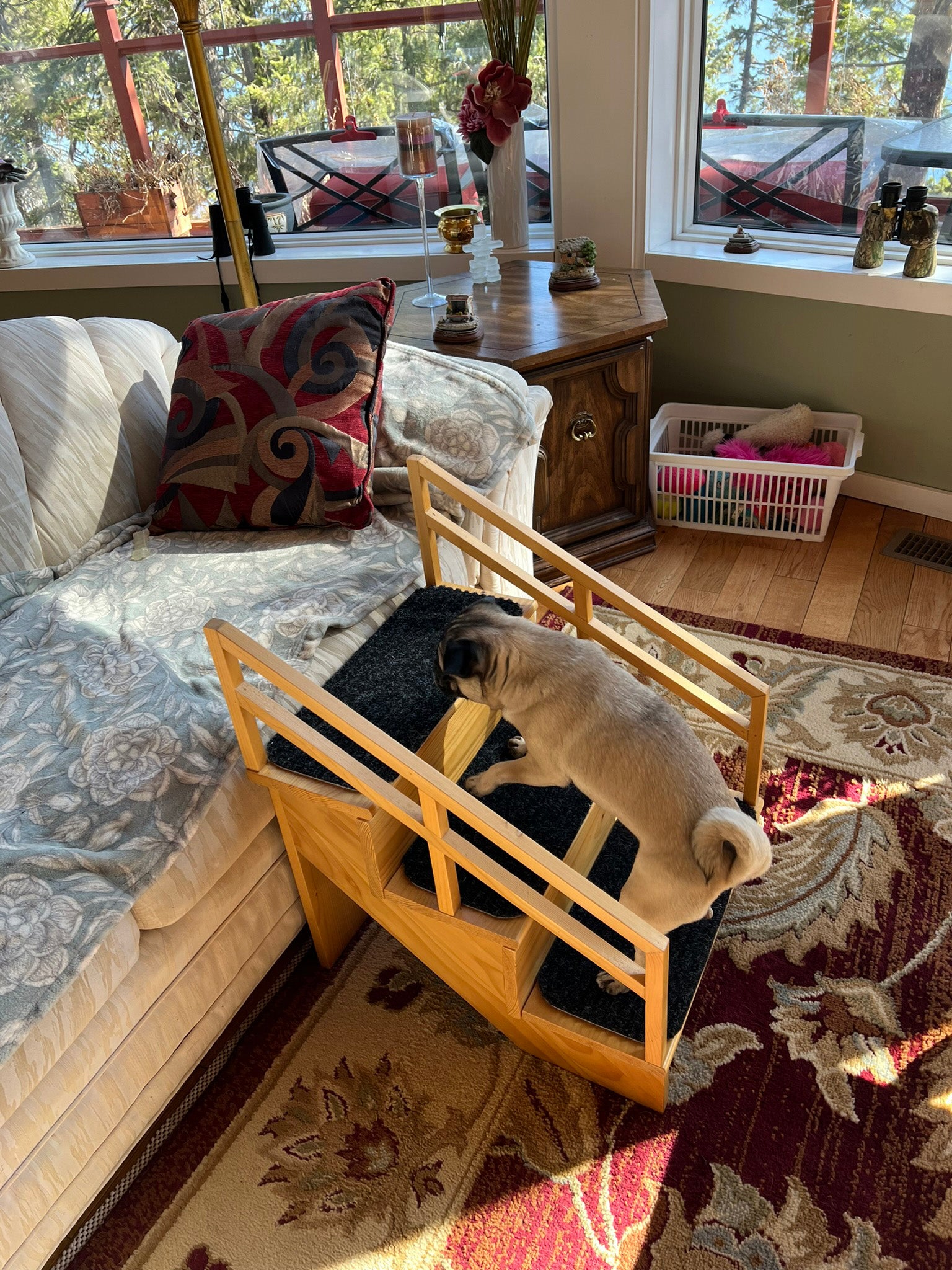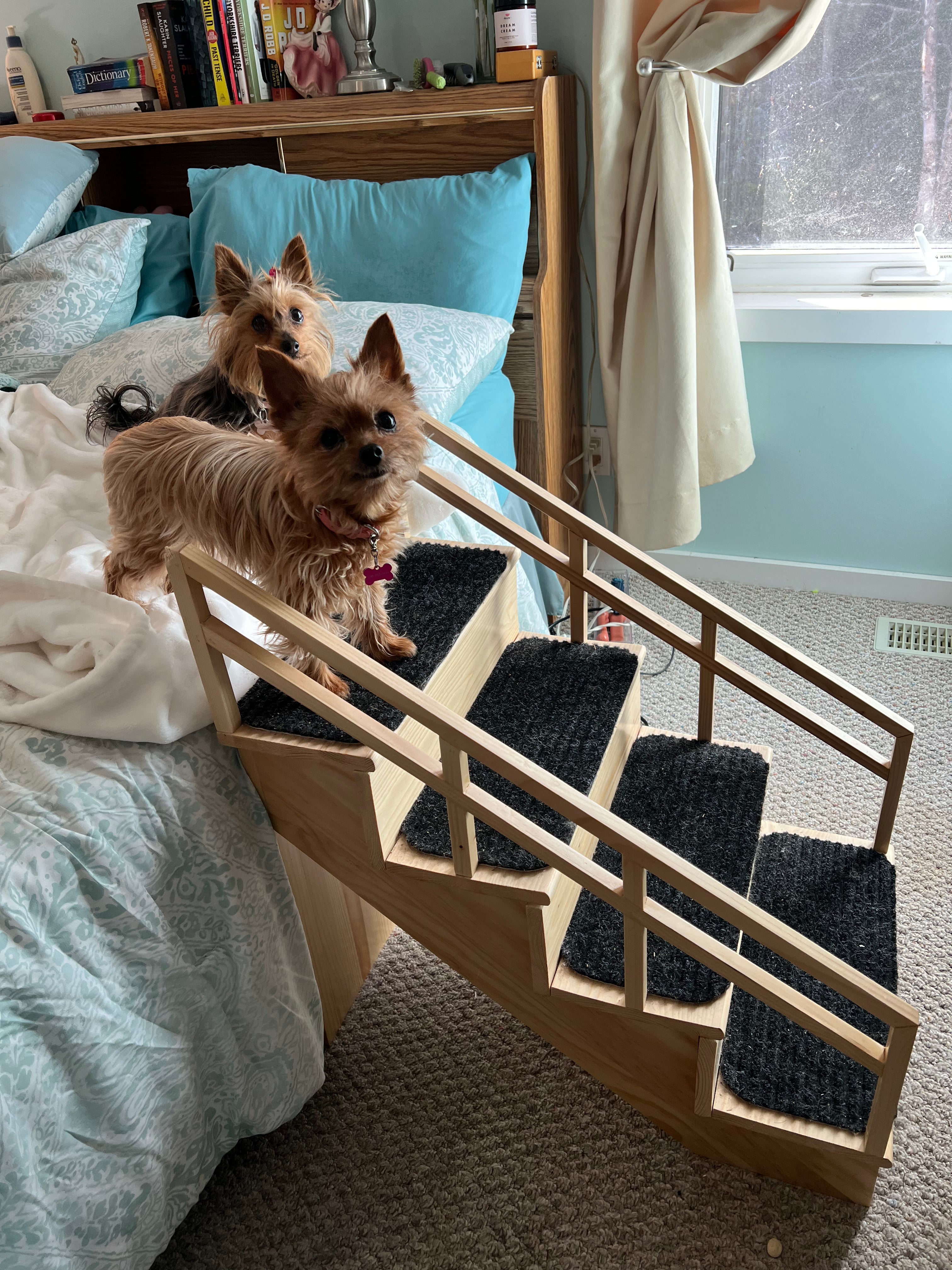
Dog Stairs vs. Dog Ramps - Which Is Best for My Senior Dog?
Pet Steps and Dog Ramps Both Help So How Do I Decide?
I cringe at the number of injuries I have seen caused by dogs jumping on and off furniture, especially beds, and it is so avoidable. It is our responsibility as pet parents to ensure the safety and well-being of our furry family members and thankfully there are many ways we can do this. One of the ways that we can protect them from physical harm and enhance their mental well-being is by giving them safe ways to access their favorite places such as beds and couches. But which is best for your dog? Let's compare dog stairs vs. dog ramps by looking at both pros and cons to help you decide which is the best option.
Are Dog Stairs and Dog Ramps Just for Older Dogs?
There is a common misconception that pet steps and pet ramps are only needed for senior dogs or special needs dogs. While dogs with mobility issues need them more, both dog steps and ramps can be an important way to protect all dogs from serious injury caused by jumping. I would argue that having these assistive products in your dog's life when they are young is the best way to train them to use the dog stairs or dog ramp as their sole means of getting up and down from your couch or bed. One of the challenges in introducing steps or ramps later in life is that your dog has probably already formed a habit of jumping since that was their only option, so having to re-train them to not jump is more challenging. Don't worry though, with a bit of time, patience, and some treats you can teach your dog to use and love their dog stairs and/or dog ramp.
Dog Stairs Pros and Cons

Like with everything there are benefits and drawbacks so let's go over both when it comes to dog stairs.
Benefits of Pet Steps
- Joint Health - Dogs with arthritis can actually benefit from climbing up manageable steps as it can help increase their range of motion, build muscle strength, and improve proprioception.
- Avoid Injury - When a dog jumps either onto or off of a couch or bed they risk injury with every leap. Common injuries are sprains, broken bones, and spinal trauma. Jumping from soft to hard surfaces or hard to soft surfaces increases the risk. There is also a chance that your dog could jump down and land on a toy or a bone causing them to lose their footing leading to injury. In addition, many breeds such as Frenchies, pugs, corgies, and dachshunds, etc. are susceptible to degenerative disc conditions such as Intervertebral disc disease (IVDD) and jumping can have severe consequences, at times even leading to paralysis. You may not even be aware that your dog has disc degeneration and is more vulnerable until an injury happens, so it is always best to be preventative.
- Space Efficiency - Dog steps do not typically take up a lot of space and depending on your home may fit better than a ramp would.
- Familiarity - Most dogs are already comfortable navigating steps since most homes have staircases so they already know how to use them.
- Restores Confidence and Independence - Just like people, dogs love to be able to do for themselves. As they age and become more dependent on their humans they begin to lose their confidence and independence which in turn impacts their mental health. Dog stairs are a simple way to help restore their independence and enable them to feel more capable and confident which does wonders for their self-esteem.
Drawbacks of Dog Stairs vs. Dog Ramps
- Strain on joints - If your dog has severe problems with dysplasia or arthritis the motion required to climb may prove too painful or difficult. Also going down steps puts a lot more pressure on a dog's front legs so if they have elbow or wrist issues this may be more challenging for them than a ramp.
- Size of your dog - The size of the steps can impact their usability. If the steps are too narrow, with not enough space, larger dogs may not be able to use them. If the steps are too tall with a lot of space between steps then small dogs may not be able to use them. It is important to find a size of steps that works for the size of your dog so they are not straining or trying to use steps that do not allow them to ascend and descend safely.
- Cheating - For steps without safety rails dogs will often cheat by only walking part of the way down and then jumping off early. This can be just as risky as jumping off your bed or couch which is why our Gentle Rise Pet Steps have safety rails on both sides!
Dog Ramp Pros and Cons

While ramps offer many benefits they may not be the solution for every situation. Let's review the benefits and drawbacks of dog ramps.
Benefits of Dog Ramps
- Gentle on Joints - Dog ramps, as long as they have a gentle incline, reduce stress on joints and minimize the impact on arthritic limbs.
- Accessibility for Larger Breeds - Larger dog breeds prone to hip and joint issues may find ramps more accommodating than steps. The gradual slope allows for a smoother ascent or descent, catering to the specific needs of bigger dogs.
- Injury Prevention - Just like with steps giving your dog a safer alternative for accessing your bed and couch can reduce the risk of injuries from jumping. Having a ramp with a gradual slope and a safety rail is key.
- Easier to Use - For dogs with severe mobility issues, reduced range of motion and balance issues a ramp can be the safer choice. Dog ramps with a gradual slope are often easier for dogs that may no longer have the strength, balance, or vision to navigate steps.
- Improves Self-Esteem - Similar to pet steps, the positive impact that restoring your dog's confidence and independence cannot be overstated. They are just like us in that with age comes feelings of vulnerability, so anything we can do to make them feel safe and allow them to help themselves will have a profound impact on their mental well-being. Watching your senior dog or special needs dog walk up and down a ramp when they may not have been able to access your couch or bed unassisted before will truly melt your heart.
Drawbacks of Dog Ramps vs. Dog Stairs
- Unfamiliarity - Most dogs have never used a ramp before so getting them to use a dog ramp can often take time and patience before they are comfortable with this new and often foreign concept. Using treats and toys is a great way to get them used to going up and down the ramp.
- Space Required - Pet ramps typically take up a lot more space than pet steps. It requires significant length to achieve a gradual slope with a ramp, but having this manageable incline is key.
- Cheating - Much like with steps, if your dog ramp does not have a safety rail your dog will often cheat and jump off the ramp early putting them in harm's way.
Dog Stairs vs. Dog Ramps - Which Is Best For My Senior Dog?

While young dogs can use either steps or ramps without much thought, when it comes to senior or special needs dogs the decision is much more complicated because we need to factor in their physical capabilities. If your dog is still active and mobile then steps are the easier choice since they take up much less space, but if your dog has more severe mobility issues and struggles with steps, or if they have vision issues making steps more intimidating and risky, then I would recommend a ramp.
Ultimately I feel that it comes down to each dog and their physical capabilities as well as their personalities. You know your dog and I believe you can make the decision quite easily. Or you may find that you could make good use of both to help cover more areas in particular when it comes to your bed. You could put a bed ramp at the end of your bed and dog stairs at the side as an example. For the couch, pet steps certainly fit better in most living rooms than a ramp does, but again it really depends on your dog.
Whatever you decide, whether dog steps or a dog ramp or both you have made a great choice that will help to protect your dog from injuries, restore their confidence, and ultimately improve their quality of life. And that's what really matters.
Ann-Marie Fleming is the Founder & CEO of Dog Quality, a provider of innovative assistive products focused on improving the quality of life for older dogs and the families that care for them.

